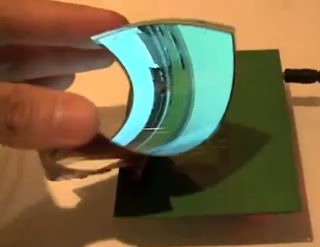Wonder material "Graphene" could transform phones forever
Graphene is going to revolutionize the 21st Century. Graphene is made of a single element, carbon, arranged in a flat, constant crystal pattern that looks like chicken wire. Although it may sound rare and complex it is simply very thin layers of graphite - the same as establish in a ordinary pencil. In fact it's now realized that nearly every stroke of a pencil leaves fragments of Graphene in the bright grey trail on the paper.
What makes Graphene remarkable is its ability to take on any of these roles. It can conduct electricity better than copper, has strength greater than steel and also shows extraordinary elasticity. In 2010, it is discovered by Andre Geim and Konstantin Novoselov were awarded the Nobel Prize for Physics.
Not only have thousands of scientific papers been published describing Graphene's many aspects;
over 7,000 patents have been issued, many on technologies that may possible end up in mobile phones. No wonder Electronics giant Samsung has invested huge sums into developing Graphene
as a meterial for screens and electronics; Nokia is backing a billion-euro project to exploit the carbon meterial and IBM has started a formidable research effort.
The meterial is cheap, see-through and critically is electrically conductive. That makes it ultimate for the flat-cover displays used on smart phones that need electricity to potential the optical elements and to the user touch.
The circuit was a so-called broadband radio-frequency mixer, an essential component of TV's, Phones and Radio, but very different from the complex logic chip found at the heart of a smartphone or laptop. The circuit is generally used to convert the high frequency signals broadcast by radio stations to a lower frequency that we can hear.
The circuit exploited the high speed of electrons in Graphene, something that may also make Graphene ideally suited to handle the high frequencies of mobile phone transmissions - both in the receiver and in generating the signal to send out to the base station.
Samsung and Nokia have already shown off concepts for "Bendy" phones - such as the newly unveiled Samsung "YOUM" cover or Nokia "Morph" concept - with shapes unlike anything seen today. Although less farthest versions of some of these concepts may first be brought to market by more conventional technology, Nokia researchers believe that "Graphene may well be one of the crucial elements of making Morph reality".
Bend and Flex mobiles soon:
Mobile phones that fold, razor thin handsets powered by flexible batteries or translucent solar panels built directly into a colorful screen. These visions of our mobile future may assume a world away from our rigid, fragile and power-hungry Smartphone's today.
The 'unbreakable' mobile phone: Samsung shows off radical paper thin flexible screen
- screen is made by overlaying components onto
plastic instead of glass
- OLED screens are able to flex easily, and can
even be use to create radical 'Curved' phone
designs
Samsung is gearing up to produce flexible, unbreakable mobile phone screens that can be bent, twisted and even folded up and put in your wallet.
The South Korean tech giant reportedly has the flexible screens in the final stage of development and will be ready to ship them soon. The bendable smartphone devices are being branded YOUM.
Nokia's prototype flex-phone may revolutionize mobile devices:
Nokia appears to be the first company to come up with a working prototype of a smart mobile phone that you can bend flex to perform actions like zoom, scroll or take a picture. Already seen this concept with the paper thing concept phone or more of a graphical design with a Galaxy Android.
Neither took it as far as Nokia has built a working prototype mobile that could come to market in the near future. This should bring us even closer to have smart mobile devices that we can bend to perform actions. Don't know about making calls or typing to write a text, but for actions like zoom and scroll, I think this could be great.
Sony and LG are also developing devices the flexible OLEDs
Sony has built a machine that can make rolls of the meterial 100m long - claimed to be the largest sheets in the world. Sony demonstrated a 2.5-inch flexible color screen, which is claimed was the first of its type in the world. Since then, different interpretations of these basic ideas have appeared on some interesting, low volume products, which used a flexible E-lnk screen.
An offshoot of this technology is LG Electronics paper displays or EPD, as shown recently on the Wexer Flex ONE e-reader. LG's EPD screens are higher resolution than most standard E-lnk displays, plus they are lighter, thinner and more bendy too.
The IBM researchers have made Graphene components that operate up to 150 GHz, well above the frequencies currently used by mobile phones and in principle opening up new portions of spectrum for cell phone coverage and improving connectivity.





